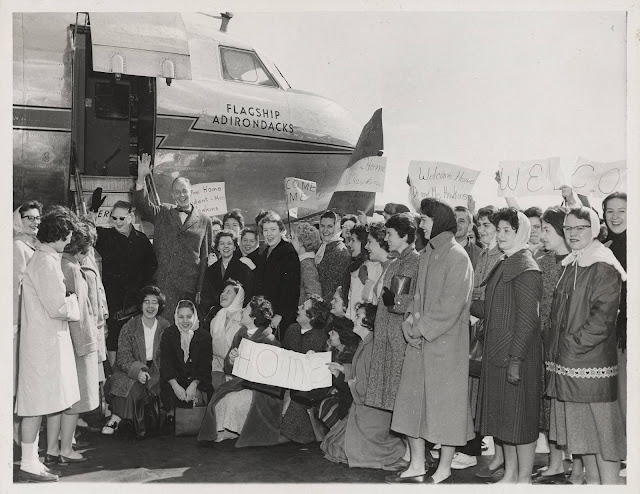
In November of 1959, Juanita Hawkins, wife of State Teacher College [STC] President Dr. Earle Hawkins, set sail with a friend for the Philippines on the USS Paradise Mist. Dr. Hawkins was already in Manila and had been since September of that year. He was serving as an adviser to the Philippines government and helping to evaluate the school system there as part of a six-member team of American educators. This team worked under the International Cooperation Administration of the U.S. government.
Mrs. Hawkins’ plan was to sail through the Panama Canal, and visit Hong Kong, Japan and other places in the Philippines before joining Dr. Hawkins in December. After his work ended, they would return to the US “by way of Southern Asia, the Middle East, northern Africa, and southern Europe.”
Mrs. Hawkins, formerly Juanita Greer, was already a seasoned traveler. In the late 1930s, while she was working as the Director of Dormitories and Dietitian at STC, Miss Greer traveled to Cuba for a wedding and wrote about the experience for the Towerlight.
The Philippines was a fairly new democracy at that time. They’d won independence from the US in 1946 after being ruled by Spain, beginning in the 1500s, and then became a US territory in 1898. And while education was of paramount importance to the government, as the Towerlight reported in September of 1959, “There is a shortage of qualified teachers, a shortage of adequate facilities, and a shortage of materials of instruction. There is also grave concern because large numbers of pupils drop out of school long before they have finished the elementary grades.” It was hoped that the evaluation team would be able to review the entire educational program in the country “and make recommendations which would perhaps have more weight because they would come from persons who had no political connections.”
|
|
The Towerlight, however, was more interested in the cultural experience the Hawkins had while abroad than about any impact Dr. Hawkins’ work may have had on the Philippines. The articles that followed his and Mrs. Hawkins’ journey are rife with tidbits about their travels.
“During his stay,” reported the Towerlight in 1959, “Dr. Hawkins is dressing according to the way the men of his profession dress in Manila. The dress includes not wearing coats or hats because of the heat. Most of the shirts are worn outside of the trousers like an overblouse.”
While in Manila, Dr. Hawkins stayed with two other members of his team in a house that was part of a walled and gated compound. There was little furniture, but there was “a filipino houseboy”.
Dr. Hawkins also suffered a mishap while in Manila. On September 21, while “on his way to breakfast”, Dr. Hawkins fell and crushed his right elbow. This meant a hospital visit and a “cast which went from his shoulder to his fingers. Although the doctors expected Dr. Hawkins to remain in the hospital for two weeks, he was discharged in five days.”
The following spring the Towerlight again was keeping up with the Hawkins’ travels. Mrs. Hawkins reported back that while in Japan “she did not wear shoes inside and slept on the floor.” While looking at a temple, the Hawkins encountered children on a school field trip. “As they had seen very few Americans, the Japanese children regarded the tall Americans with great curiosity.”
|
|
Eating, however, was proving to be problematic. “Some Japanese restaurants place samples of the food on the menu on display. This the Hawkins found especially helpful when the menu was written in Japanese. All they had to do was show which dishes they wanted. Dr. and Mrs. Hawkins admitted they did not particularly like Japanese food.”
But the travel far outweighed the inconveniences for the Hawkins couple. In 1964, Dr. Hawkins went on a “six week study tour” with other college presidents and deans in Pakistan, to help gain “a better understanding of international problems”. Again, he would circumnavigate the globe, starting in NY, then traveling to London, Frankfurt, Munich, and Istanbul before reaching Pakistan. The return trip included stops in Bangkok, Kuala Lumpur, Singapore, Hong Kong, a return to Manila, and Honolulu.
Before heading out, Dr. Hawkins reassured the Towerlight that he “had shots for every conceivable disease.”
|
|

Dr. Hawkins retired from Towson State College in 1969. He and his wife held an auction of about 600 objects that they’d collected during their travels and needed to find new homes for before vacating Glen Esk, the President’s house.
After his retirement, Dr. and Mrs. Hawkins rented a trailer to travel the US for three months. Then in January, they returned to Asia via a Norwegian freighter, with side trips to Australia and New Zealand. They also made sure to attend the World’s Fair in Japan in 1970. Dr. Hawkins died suddenly in June of 1972. In his obituary printed in theBaltimore Sun, Dr. Hawkins love of travel was highlighted. He “had visited every state in the union, most of the nations of Asia and much of Western Europe, Africa, the Caribbean and Latin America.”



